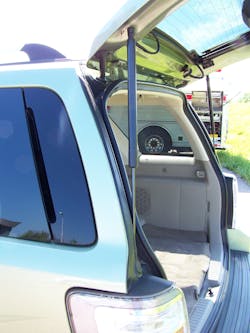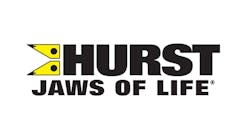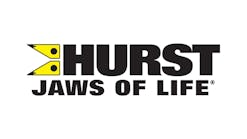University of Extrication: Liftgate and Hatchback Lifter Strut Systems
Topic: Changes in lifter strut systems
Objective: Develop tactics for lifter strut removal
Task: The rescue team shall develop techniques for lifter strut removal when removing a liftgate or hatchback
Liftgates and hatchbacks have been features on vehicles for many years. A liftgate is the door-like structure that typically opens upward and is at the rear of a vehicle such as a minivan or SUV. On a two-door or four-door passenger automobile, the large rear window structure that opens upward at the rear-most portion of the vehicle is the hatchback and is sometimes called a “fifth door” by automakers.
Rescue personnel can be confronted with jammed rear liftgates or sometimes crash-damaged hatchbacks on vehicles where these units must be forced open and completely removed to extricate the trapped occupants. Total removal of the roof of an SUV might be just one situation where the vehicle’s liftgate would need to be opened and then removed completely in order to accomplish the assignment.The standard lifter strut
Liftgates or hatchbacks are normally secured closed with one or two latches. Once opened, they all use some sort of device to hold the liftgate or hatchback in the up position. These “hold-open” devices are what we will refer to as lifter struts. They are a familiar feature but have changed significantly over the past few vehicle model years. Rescue personnel should understand the three general lifter strut designs and be prepared to deal with each of these at a crash scene.The oldest and most common type of lifter strut that responders may encounter is the standard pressurized piston-type unit. As the liftgate is manually opened, these struts are designed to extend and remain in their fully extended position to hold the liftgate up and open. These manual lifter struts can be pressurized to several thousand pounds per square inch and all have a quantity of lightweight oil inside the “fat” portion of the strut. When fully extended, these fluid-filled and pressurized struts will show a thin solid rod end and a fat tubular end that contains the pressurized fluid. These struts will be on all liftgates or hatchbacks that are opened manually. When a jammed liftgate or hatchback is forced open by rescue personnel, there is typically a need to completely remove the entire unit during an extrication incident. To do this, both manual lifter struts need to be removed. In the process of removing these standard lifter struts, rescue personnel must first open the liftgate or hatchback. They can then quickly cut through the exposed solid rod portion of each lifter strut.
If cutting is not practical, the strut can be attacked at either end to pry it or otherwise disconnect it from the vehicle. Remember, if you need to cut one of these struts, you need to be able to see the solid rod section extending from the lifter strut’s body as that is your target to cut. With the struts cut or disconnected, the hinges and wiring harness can be severed or pried free to allow the liftgate or hatchback to come completely off the vehicle.
The power liftgate
More recent model vehicles may have a second lifter strut design—the power liftgate or hatchback feature. These newer designs allow the key fob or latch device to release. Electrical, spring-loaded or hydraulic-powered lifter struts then operate to cause the liftgate or hatchback to open automatically. Once again, power lifter struts are different than the standard manual lifter design. Power lifter struts actually extend under power and as they do, the liftgate or hatchback opens remotely.For responders, the challenge with removal of power lifter struts is that they are typically thick or “fat” over their entire length. Even when at full length, it is not possible to see which end of the power lifter strut is the pressurized end, and which end has the rod component that could be cut. Some power lifter struts are like a giant jack-in-the-box and have huge coiled springs inside almost their entire length.
For power lifter strut removal, responders should not plan on cutting through the strut itself. Instead, with power lifter strut systems, plan on removing the fully extended strut by attacking it at either end—disconnecting it from the frame of the liftgate or hatchback.
Power hinge option
A third hatchback and liftgate design, one that is only a year or two old, uses power hinges to open or close the liftgate or hatchback. This latest design has no lifter struts present at all. Once opened, responders will only able to see two large hinges and the wiring harness along the rear of the roof structure.The power for opening the liftgate or hatchback and holding it open with this new system has been moved from the lifter strut to the hinges themselves. The power hinges have their drive mechanism integrated in the roof rail area. You may be able to see the thicker horizontal area along the roof rail that indicates where the power hinge lifting or opening mechanism is actually located. This roof rail area should not be cut into during extrication work.
For responders at a crash scene, each power hinge that is visible when the liftgate or hatchback is open consists of a mild steel center core wrapped with a decorative trim piece; usually a piece of plastic. To completely remove a liftgate or hatchback unit designed with the new power hinge system is relatively straightforward. Both power hinges themselves can be cut through with a cutting or sawing rescue tool. Once the wiring harness is cut, the entire liftgate or hatchback can be removed.
Caution
Be advised—liftgate and hatchback units are heavy and bulky, so assemble an adequate number of personnel to safely handle one of these units as it is being cut off and removed from the vehicle.
SIDEBAR:
Liftgate and Hatchback Removal Protocol
Standard lifter strut—Extend strut and cut solid rod or disconnect strut at either end.
Power lifter strut—Extend strut and disconnect strut at either end. Do not cut into or through a power lifter strut.
Power hinge system—Open liftgate (or hatchback) and cut through hinges and wiring harness. Avoid cutting into thick roof rail area along side of vehicle.

Ron Moore
RON MOORE, who is a Firehouse contributing editor, recently retired as a division chief with the McKinney, TX, Fire Department and now serves with Prosper, TX, Fire Rescue. He self-published the Vehicle Rescue 1-2-3 training manual and serves as the forum moderator for the extrication section of Firehouse.com . Moore can be contacted directly at [email protected].










